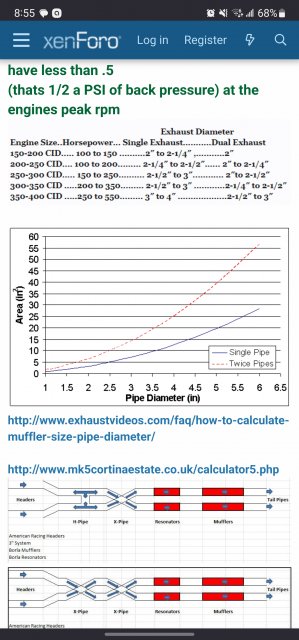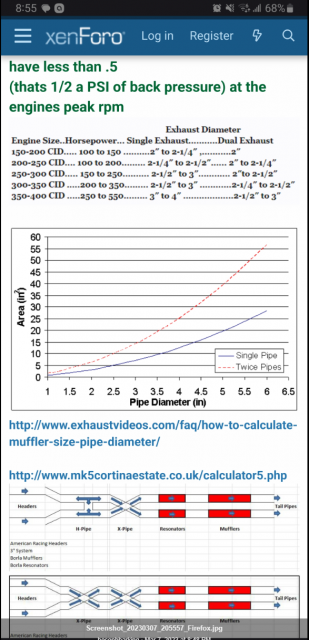Mcglsr2 you are a bit off sir. The ST has a dual 2.25" exhaust from the factory. 3 cylinders with a turbo are not maxing out the flow rate of a 2.25" pipe. A single 2.25" pipe, sure, but that's not what we have.
...but that
is what we have. If you are going to split the engine in half and say it's only 3 cylinders, you can't then follow that up with "but we have a dual 2.25" exhaust." If you split the engine, you split the exhaust. So if you want to say half is a 3 cylinder with a turbo, with a single 2.25" exhaust...then yes, I agree. You can't just throw in the dual exhaust at the end there because it suits you, the other 3 cylinders and turbo don't just disappear. Now, I'm willing to concede that 2.25" is the acceptable minimum for 3 cylinders and a turbo. Additionally, to just say "3 cylinders", that is potentially misleading, because what it comes down to is flow. We could be talking about 4 tiny pistons (half of a 3.0L v8) vs 3 larger pistons (half of a 3.0L V6). So the number of cylinders isn't nearly as important as the exhaust flow that is produced.
The second piece you seem to be missing is the stock downpipe. It isn't 3" piping. Replacing shit after it means nothing when the pipe diameter right out of the turbo is smaller.
Am I, though? What size do you think the stock downpipe is? Would you be surprised if I told you it were 2.5", NOT 2.25"? Though I do completely agree with you that any change downstream of a small downpipe is diminishing returns, especially the further away from the turbo you go (however, doing a downpipe-back is NOT meaningless - if the replacement exhaust reduces backpressure, that's a benefit; it's not ideal, but it's also not necessarily meaningless). In this case, though, the OEM exhaust "necks down" to 2.25" from the downpipe. So, while one could argue that a 3" exhaust is wasted, it kind of isn't, as it is still stepping up the OEM exhaust to at least match the downpipe. And if one plans to do more mods later anyway, who wants to buy an exhaust twice? But I will agree that part of those "mods to do later" must include 3" downpipes to get the full benefit of a 3" exhaust. Actually, an even bigger downpipe would be better, but likely won't fit in the space there.
Another piece for you, these are not twin scroll, ceramic ball bearing turbos like the vehicles you mentioned. The very turbos you speak of are extremely different and have a 3" or larger hot side.
You are making my points for me. Exactly, those cars are using turbos designed to spool as easily and quickly as possible - in other words, the exhaust has less impact on the spool, as the turbos are "better." So those cars could run a slightly worse exhaust and maybe still get great performance. Because the turbo compensates. We do not have that luxury with our journal bearing turbos. So it makes even
more sense for us to do whatever we can to help our turbos out - like install bigger exhausts. Furthermore, just because they are using better turbos does not change the fact that they are still turbos, and will work just like the ones we have in the ST. "Better" does not mean they violate the laws of physics.
There is a reason to have a little restriction right out the gate. That's due to SIZE of your turbo and its compressor mapping. Your turbo is designed to flow a specific amount of air, its a concert with a ballroom dance happening at the same time. If the dancers and players are not on the same page shit gets fucked up.
No, no and no. That is a myth that keeps getting perpetuated, and it just will not die. Restriction is BAD. Full stop. Period. End of statement. Turbos do not need nor do they like backpressure. They do not want "restriction". This is literally the absolute opposite of what a turbo wants, is backwards thinking, and comes from people who have knowledge of NA cars but not turbo cars. They keep pushing this. Yes, the turbo is designed to flow a certain amount of air. The compressor map describes what this flow is and how efficient the turbo is at doing it (the islands). And if the turbo starts to flow too much air, do you know what happens? The wastegate opens up, keeping the rotation in check.
To have one say that the exhaust is the thing that is supposed to keep the rotational rpm of a turbo in check is simply asinine, and flat out wrong. Backpressure is a byproduct of restriction - it's not there because it's desired, it's there because the components used do a piss poor job of eliminating it.
To put this succinctly, your turbo outlet and downpipes don't change in size for most people modding here. A cat back exhaust does jack crap to reduce backpressure because it's a dual exhaust already. A single 3" exhaust flows less than the dual 2.25" exhaust we have.
Yup, and the downpipes are 2.5". Which means, at a minimum, you could step up to a 2.5" exhaust and see benefit. Furthermore, you are incorrect regarding the backpressure statement. TMac does this too, he keeps trotting out the cross-sectional area of the pipes, saying that dual 2.25" is larger than 3" and that super powerful cars are running 3" and they make gobs of power, etc. etc. And he's not wrong. But he is misrepresenting the situation. If we were talking about a
piece of straight pipe, then yes, everything he says regarding the area is true. But we aren't talking about straight pipe. We are talking about an OEM exhaust, with resonators and mufflers (i.e. restrictions) designed to keep the EPA happy and the exhaust note quiet. Those 3" pipes he's talking about on other cars, those are AFTERMARKET designs, with the singular purpose of increasing flow at the expense of all else. Do you really think our OEM exhaust is a super free-flowing exhaust? Really? It's got a resonator (is it high-flowing?), those mufflers (are those big ass boxes high flowing?), crush bends (not even mandrel bent - which means that one could correctly argue that the exhaust is even smaller than 2.25" in a couple places), all that stuff. To simply state that 2.25" dual has more cross-sectional surface area than a 3" is leaving many, many details out of the equation.
For the life of me, I genuinely don't understand where you guys are coming from. And I'm honestly trying. I'm not a fan of modding just for modding-sake, so I'm not coming from there. I'm not a fan of wasting money. So if you aren't either, I get that. But there are literally thousands upon thousands of dynos out there, across many makes and models, that show gains on turbo motors stepping up to larger exhausts (and yes, especially with larger downpipes when necessary). So I really don't understand the push-back here. If you guys are trying to say that the OEM exhaust "is good enough" for a stock ST, then okay. I'm willing to concede that. But if you then want to follow that with "a larger exhaust is not necessary" then no, that is not a true statement. It is absolutely not true.
At the end of the day, a turbo exhaust section is a pressure differential device (not unlike a fuel injector in a boosted application, if you understand how they work). High pressure on the upstream side (pre turbine wheel), low pressure on the downstream (post turbine wheel). ANYTHING that increases pressure on the downstream side, without a complimentary increase on the high side,
will hurt performance. It's as simple as that.
Thank you and have a good day.
You are welcome and I'm trying my best!



